Mathematical Logic | Discrete Mathematics | Mathematics - Some Laws of Logical Equivalence | 12th Maths : UNIT 12 : Discrete Mathematics
Chapter: 12th Maths : UNIT 12 : Discrete Mathematics
Some Laws of Logical Equivalence
Mathematical Logic
Logical
Equivalence
Definition 12.20
Any two compound statements A
and B are said to be logically equivalent
or simply equivalent if the columns corresponding to A and B in the truth
table have identical truth values. The logical equivalence of the statements A and B is denoted by A ≡ B
or A ⇔ B .
From the
definition, it is clear that, if A
and B are logically equivalent, then A ⇔ B
must be tautology.
Some
Laws of Equivalence
1. Idempotent Laws
(i) p ∨ p ≡ p
(ii) p ∧ p ≡ p .
Proof
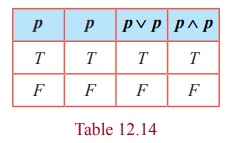
In the above truth table for both p , p ∨ p and p ∧ p have the same truth values. Hence p ∨ p ≡ p and p ∧ p ≡ p .
2. Commutative Laws
(i) p ∨ q
≡
q ∨ p
(ii) p ∧ q
≡
q ∧ p
.
Proof
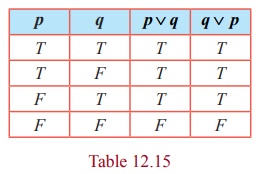
The
columns corresponding to p ∨ q
and q ∨ p
are identical. Hence p ∨ q
≡
q ∨ p
.
Similarly
(ii) p ∧ q
≡
q ∧ p
can be proved.
3. Associative Laws
(i) p ∨ ( q
∨ r
)
≡
(
p ∨ q
)
∨ r
(ii) p ∧ ( q
∧ r
)
≡
(
p ∧ q
)
∧ r
.
Proof
The
truth table required for proving the associative law is given below.

The
columns corresponding to ( p
∨ q
)
∨ r
and p ∨ ( q
∨ r
)
are identical.
Hence p ∨ ( q
∨ r
)
≡
(
p ∨ q
)
∨ r
.
Similarly,
(ii) p ∧ ( q ∧ r ) ≡ ( p ∧ q ) ∧ r can be proved.
4. Distributive Laws
(i) p ∨ ( q ∧ r ) ≡ ( p ∨ q ) ∧ ( p ∨ r)
(ii) p ∧ ( q ∨ r ) ≡ ( p ∧ q ) ∨ ( p ∧ r)
Proof (i)

The columns
corresponding to p ∨ ( q ∧ r) and ( p ∨ q ) ∧ ( p ∨ r) are identical. Hence p ∨ (
q ∧ r )
≡ ( p ∨ q )
∧ (
p ∨ r)
.
Similarly
(ii) p ∧ ( q ∨ r ) ≡ ( p ∧ q ) ∨ ( p ∧ r) can be proved.
5. Identity Laws
(i) p ∨ T ≡ T and p ∨ F ≡ p
(ii) p ∧ T ≡ p and p ∧ F ≡ F
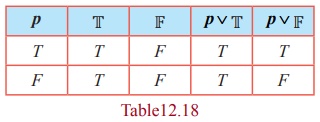
(i) The
entries in the columns corresponding to p
∨ T and T are identical
and hence they are equivalent. The entries in the columns corresponding to p ∨ F and p are identical and
hence they are equivalent.
Dually
(ii) p ∧ T ≡ p and p ∧ F ≡ F can
be proved.
6. Complement Laws
(i) p ∨ ¬ p
≡
T and p ∧ ¬
p ≡ F (ii) ¬T
≡ F and ¬F ≡ T
Proof

(i) The
entries in the columns corresponding to p
∨ ¬ p
and T are identical and hence they
are equivalent. The entries in the columns corresponding to p ∧ ¬ p
and F are identical and hence they
are equivalent.
(ii) The
entries in the columns corresponding to ¬T
and F are identical and hence they
are equivalent. The entries in the columns corresponding to ¬F and T are identical and hence they are equivalent.
7. Involution Law or Double Negation Law
¬(¬ p) ≡ p
Proof
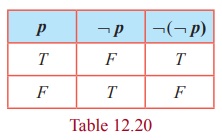
The
entries in the columns corresponding to ¬ ( ¬p)
and p are identical and hence they
are equivalent.
8. de Morgan’s Laws
(i) ¬
(
p ∧ q)
≡
¬
p ∨ ¬q
(ii) ¬
(
p ∨ q)
≡ ¬p ∧
¬q
Proof of (i)

The
entries in the columns corresponding to ¬ ( p
∧ q
)
and ¬
p ∨ ¬q are identical and hence they are
equivalent. Therefore ¬ ( p
∧ q)
≡
¬
p ∨ ¬q . Dually (ii) ¬
(
p ∨ q)
≡ ¬p ∧
¬q can be proved.
9. Absorption Laws
(i) p ∨ ( p ∧ q ) ≡ p
(ii) p ∧ ( p ∨ q ) ≡ p

(i) The
entries in the columns corresponding to p
∨ ( p
∧ q)
and p are identical and hence they
are equivalent.
(ii) The
entries in the columns corresponding to p
∧ ( p
∨ q)
and p are identical and hence they are
equivalent.
Example 12.17
Establish
the equivalence property: p →
q ≡ ¬ p
∨ q
Solution
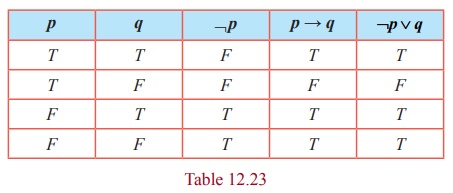
The
entries in the columns corresponding to p
→
q and ¬ p
∨ q
are identical and hence they are equivalent.
Example 12.18
Establish
the equivalence property connecting the bi-conditional with conditional:
p↔ q ≡ ( p → q ) ∧ (q → p)
Solution

The
entries in the columns corresponding to p
↔ q and ( p → q ) ∧ ( q → p) are identical and hence
they are equivalent.
Example 12.19
Using
the equivalence property, show that p
↔
q ≡ ( p ∧ q ) ∨ ( ¬ p
∧
¬q) .
Solution
It can
be obtained by using examples 12.15 and 12.16 that
p ↔ q ≡ ( ¬ p ∨ q)
∧ (
¬q ∨ p)
... (1)
≡ (¬ p ∨ q) ∧ ( p ¬q) (by
Commutative Law)
... (2)
≡ ( ¬ p
∧ ( p ∨ ¬q )) ∨
( q ∧ ( p ∨ ¬q)) (by Distributive Law)
≡ ( ¬ p
∧ p)
∨ ( ¬p ∧ ¬q) ∨ ( q ∧ p) ∨ ( q ∧ ¬q) (by Distributive Law)
≡ F ∨ ( ¬p ∧ ¬q) ∨ ( q ∧ p) ∨ F; (by Complement Law)
≡ ( ¬ p
∧ ¬ q
) ∨ ( q ∧ p) ; (by Identity Law)
≡ ( p ∧ q
) ∨(¬ p
¬q) ; (by Commutative Law)
Finally
(1) becomes p ↔
q ≡ ( p ∧ q ) ∨(¬ p
¬q) .
Related Topics